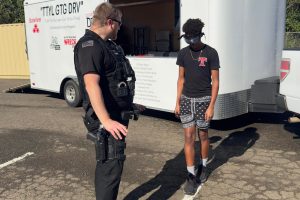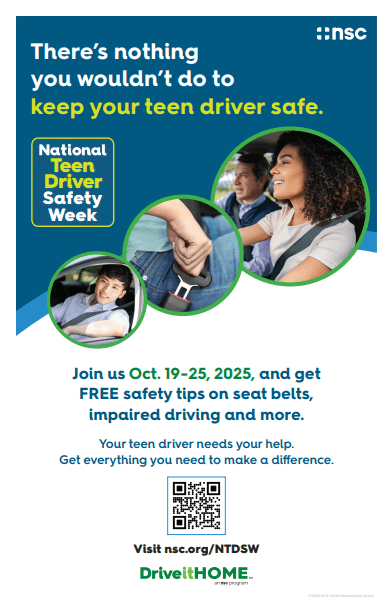Tillamook Police Department is teaming up with Tillamook High School to support National Teen Driver Safety Week, October 19-25, 2025. On Tuesday, October 22nd during school hours Teen Drivers will have the opportunity to drive a golfcart on a cone course simulating distractive and impaired driving. It is important to discuss safe driving habits with teens every day, but Teen Driver Safety Week serves as an opportunity for parents and guardians to have a conversation with teens about safe driving habits. Teen drivers need to know the Rules of the Road before parents hand over the keys. Ultimately, it’s parents who are in control.
Traffic crashes are a leading cause of death for 15-20-year-olds. In 2023, there were 2,611 people killed in crashes involving a teen (15 to 18 years old) driver, and 822 were teen drivers themselves. Of the 2,611 people killed in crashes involving a teen (15-18 years old) driver, 604 were the passengers of a teen driver, and 377 (62%) of those fatalities were other teens riding with a passenger vehicle teen driver. Of those teen passengers killed while riding with another teen driver, 67% were male and 33% were female.
 “Parents play a critical role in teaching teen drivers safe driving habits,” said Chief Troxel. “New teen drivers are gaining experience behind the wheel, which increases the chance of dangerous situations for the teen and other roadway users around them,” School Resource Officer Olson said.
“Parents play a critical role in teaching teen drivers safe driving habits,” said Chief Troxel. “New teen drivers are gaining experience behind the wheel, which increases the chance of dangerous situations for the teen and other roadway users around them,” School Resource Officer Olson said.
It’s important for parents to model safe driving behaviors themselves and have discussions with their teens about the choices they make behind the wheel. NHTSA offers parents and guardians helpful tips and a framework for having discussions with teen drivers about risky driving behaviors that can lead to fatal consequences.
It’s a parent’s responsibility to help teen drivers make smart choices to stay safe on the road. NHTSA gives parents and guardians tips on how to talk about safer driving. These tips include discussions on how to influence positive behaviors and how to approach dangerous driving behaviors such as alcohol and other drug use, lack of seat belt use, distracted driving, speeding, or driving with passengers. Surveys show that teens whose parents set firm rules for driving typically engaged in less risky driving behaviors and were involved in fewer crashes. Teens need to understand the rules, whether there are any other restrictions outlined in Oregon’s graduated driver licensing law, and the deadly consequences that could occur.
For more information about teen driver safety, visit www.nhtsa.gov/road-safety/teen-driving.



